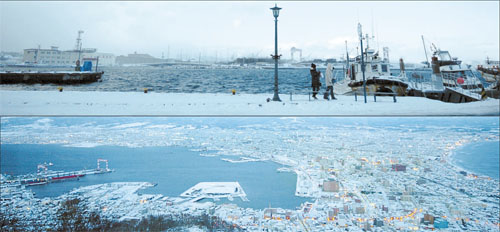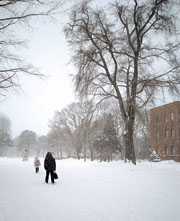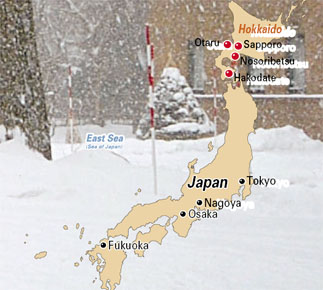Icy weather, steamy springs

A view of the harbor and a bird’s eye view of Hakodate.
The journey to the northern regions of Japan began at Hakodate International Airport, where I took the bus to the city of Hakodate, the third largest on Hokkaido.
The road to Hakodate passes the famous hot spring village of Yunokawa. It takes roughly 25 minutes or so by bus (200 yen, $1.88) to arrive at the Hakodate JR train station. The great thing about this port town is that its tourist attractions are accessible on foot, although you can take the tram.
Unfortunately, Sunday morning isn’t the best time to visit Hakodate. The morning markets selling the famous Japanese crab kani, the restaurants and commercial stores are closed.
Yet a walk to the bay area is pleasant. The neighborhood looks like a European city. The harbor city was one of the first areas in Japan that opened up to foreigners’ influence in the late 19th century. The beautiful red-brick warehouses along the harbor are now stores selling Hakodate Beer, dairy products, puddings and souvenirs.

Top to bottom: Warehouses along the bay area of Hakodate, the former Sapporo Government building in Sapporo, Sapporo Beer Museum, a ramen shop at Sapporo Ramen Yokocho, TV Tower at Odori Park, Otaru Train Station.;A 50-year old manju shop at Otaru, Otaru canal, Noboribetsu’s Hell Valley and a local onsen at Yunokawa near Hakodate. By Lee Ho-jeong
There’s a teddy bear shop, a road that resembles the steep hills of San Francisco along the trail to Mount Hakodate, a Russian Orthodox Church and many other European buildings.
Once at the bottom of Mount Hakodate, visitors can ride a cable car for 1,100 yen round trip. The best time is just before sunset. From an indoor space at the top of the mountain you can watch the city colors change at sunset. It’s a breathtaking moment. However, dress warmly because the peak is freezing.
I could have spent the night here but instead chose to take the 1 a.m. train to Sapporo, the main city on the northernmost Japanese island. The trip takes five hours and there’s lot more to see and a lot more people here.
After breakfast to warm myself from the bitter cold at the Sapporo JR station, I traveled to Hokkaido University campus, a 10-minute walk from the station. Most of the attractions in Hokkaido’s cities are within walking distance.
Hokkaido University was founded in 1876, and the huge campus looks enchanting under a blanket of snow. There are small streams, bridges and lines of tall poplar trees.
Another 10-minute walk from the university campus is the former Hokkaido government office building. This red-brick European building has a wonderful garden where ducks waddle around a nearby lake. Inside is a display about the history of the building, the governor’s former desk and a brief history of Sakhalin, the last of which is unfortunately only in Japanese.
Just a block away from the office is the Sapporo Clock Tower, which dates back to the 19th century. You can view the tower from the outside or pay the 200-yen entrance fee. I, on the other hand, turned around. I wanted beer, and on this frosty day I fancied a trip to the Sapporo Beer Museum, a 30-minute bus ride away.
To be honest, other than the red-brick buildings that remind you of the Victorian era, there’s not much to see at the beer factory. In fact, the inside of the of building, built in July 1987, is almost vacant except for the enormous brewing equipment and a miniature fantasy beer world. At the end of a very short tour, which costs 400 yen, visitors can sample Sapporo Black Label, Yebisu Black and Kaitakushi Beer accompanied by cheese, peanuts or beef jerky.
When night fell, I headed to Susukino Station, which turns into a glamorous, neon-lit street after sunset. Japanese food is delicious, especially the puddings. Another must-eat item is the sio ramen. Sio in Japanese means salt, but you can also choose from miso, bean paste and soy sauce. The best I have ever tasted is the siho variety.
The best place to enjoy a bowl is at Sapporo Ramen Yokocho, which is a narrow street less than 50 meters in length. Here, you can find a cluster of ramen shops lined up. For 700 yen, you can get a satisfying dinner. For those with a heavier appetite, the shops also offer fried dumplings at 400 yen. There is also a crepe shop nearby, as well as a shop for takoyaki, or fried octopus. The latter really delighted my palate.
The next morning, the JR Station was my first stop on my journey to Otaru, a small town quite close to Sapporo. A 35-minute ride to the west of Sapporo gets you there. Otaru is famous for its canal, music box museum, delicious chocolates, sushi and manju, a Japanese confection filled with red bean paste.

North of the train station is the canal. The water is clear and the Victorian-era architecture appears again. European street lamps line the bank of the canal. However, for being a major attraction, it was disappointingly short. My short walk felt like it was ending abruptly.
In the mood for more strolling, I decided to head toward the music box museum to check out its wares ― everything on display is on sale ― and its steam-run clock. The museum surpassed my expectations. The wide variety of music boxes provided an enjoyable outing. Most novel was a music box in the shape of a sushi roll. However, the puny steam clock was a disappointment. Hungry from all the walking, I returned to Sapporo for another bowl of ramen.
My destination the next morning was Noboribetsu, which is known to be one of the three major towns for onsen, or hot springs, in Japan.
My to-do list in Noboribetsu had three items: Tour Jigokudani, or Hell Valley; check out the clockwork statue of Enma, “the gatekeeper of Hell,” and enjoy a hot spring.

At my chosen onsen, Yumoto Sagiriyu (390 yen, open from 7 a.m. to 9:30 p.m.), I let the steamy water wash away the fatigue of my trip. I could actually feel my skin grow smoother under the murky waters.
The next day at Hakodate, before my departure from the land of snow, I stopped at a famous Yunokawa onsen near the airport. It was tiny and old-fashioned, but it had the hottest spring I have ever experienced.
The trip didn’t end up being the most relaxing, but I definitely felt purified after a trip away from Seoul’s pollution. And that’s definitely worth a smile.
By Lee Ho-jeong Staff Reporter [ojlee82@joongang.co.kr]










with the Korea JoongAng Daily
To write comments, please log in to one of the accounts.
Standards Board Policy (0/250자)